Adventures with Fruit: Pindo (Jelly) Palms
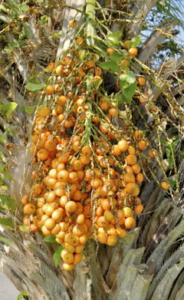 Evaluating the usefulness of the plants in your yard is a big part of permaculture; once you understand what each plant does, you will know if it is useful either to you, to wildlife or to the environment, or if it is causing harm. There are many food-producing plants that we think of as weeds or as ornamentals. Always, always, always be sure before you pop something in your mouth. So by identifying your plants you can add to your diet, and if something is already successfully growing in your yard and you can use it, fantastic!
Evaluating the usefulness of the plants in your yard is a big part of permaculture; once you understand what each plant does, you will know if it is useful either to you, to wildlife or to the environment, or if it is causing harm. There are many food-producing plants that we think of as weeds or as ornamentals. Always, always, always be sure before you pop something in your mouth. So by identifying your plants you can add to your diet, and if something is already successfully growing in your yard and you can use it, fantastic!
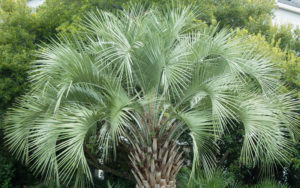 You’ve probably walked past them, or even looked askance at the dropped fruit without realizing. Also called Jelly Palms, the pindo palm is a common landscape tree for drought-tolerant hot areas. The fronds look very pokey, but are rather soft. That is a relief because once you’ve tasted the ripe fruit you’ll be thrashing through the fronds trying to pick more of them.
You’ve probably walked past them, or even looked askance at the dropped fruit without realizing. Also called Jelly Palms, the pindo palm is a common landscape tree for drought-tolerant hot areas. The fronds look very pokey, but are rather soft. That is a relief because once you’ve tasted the ripe fruit you’ll be thrashing through the fronds trying to pick more of them.
Pindo palms (Butia capitata) are called Jelly Palms because the fruit has a lot of pectin in them. The trees are also called Wine Palms because you can make a cloudy wine from the fruit. But then, mankind has proven that you can make alcoholic beverages from just about anything.
The fruit is small and fiberous with a big seed, and falls to the ground when very ripe. They taste amazing. The burst of flavor is as if a pineapple and an apricot had a little yellowish baby. The best way to eat them is to gently chew the whole thing and swallow the juice, then spit out the fiber and seed.
We have two jelly palms at Finch Frolic Garden, only because they didn’t have identification we didn’t really know what they were. At the beginning of this year Miranda and I were evaluating the garden plants using the Three Positives rule (where everything in the garden has to give you three positive things. If it doesn’t, then it should be turned into hugelkultur or mulch). Several trees were repurposed and we were eyeing the palms. These palms are squat and short, not slim and tall like the very similar Queen palms. Fortunately for them, and as it turned out, for us, the trunks were too thick for my small chainsaw so we didn’t remove them with the others. This threat seemed to work because they set fruit on long stalks. We hesitantly tried one… and then just about ran each other over trying to get more!
Queen palms also produce an edible fruit that is sweeter, but is only edible when very ripe.
The fallen ripe fruit can attract bees and wasps because, well, everyone wants some. We waited until the stalks were just about completely ripe then cut them off and left them in a paper bag. The fruit then ripened and dropped off in the house where we could have them all.
Most of what I know about the Pindo Palm comes from the website Eat the Weeds by Greene Deane.
We cleaned them and froze them. Now we’re making Pindo Palm Jelly. Or maybe Jelly Palm Jelly, which sounds better.
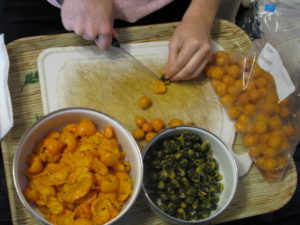 Freezing and thawing the fruit actually helps break down some of the fiber and release juices, and makes them much easier to pit. The pits are high in oil, so advice for cooking the fruit whole says the jelly can pick up bitter flavor from the seeds. We sat with trays laden with cutting boards, a knife and bowls and pitted them. Yes, this is how we spend our evenings when I’m not out dancing, processing fruit and watching a movie or reruns of the Bob Newhart show or something. Yep.
Freezing and thawing the fruit actually helps break down some of the fiber and release juices, and makes them much easier to pit. The pits are high in oil, so advice for cooking the fruit whole says the jelly can pick up bitter flavor from the seeds. We sat with trays laden with cutting boards, a knife and bowls and pitted them. Yes, this is how we spend our evenings when I’m not out dancing, processing fruit and watching a movie or reruns of the Bob Newhart show or something. Yep.
The thawed fruit was easy to push away from the seed, so the process went very quickly although our fingers were pretty cold from the fruit.
We covered the pitted fruit with water and cooked it for about an hour, then strained out the fruit. There isn’t a lot of pulp because of all the fiber. 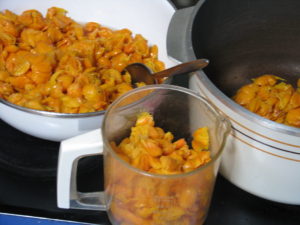 We used the National Center for Home Food Preservation’s recipe which used a lot of sugar, but the juice is so tart that it needed it.
We used the National Center for Home Food Preservation’s recipe which used a lot of sugar, but the juice is so tart that it needed it.
What we got was a beautiful jelly that,despite the natural and added pectin was fairly loose. The benefit was that it can be used as a syrup as well. While the flavor of the jelly isn’t quite as astonishing as the fresh fruit, the tart tropical flavor is very good.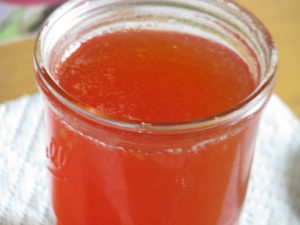
So walk around your weeds and trees and identify them, read up on them, and perhaps you can find a treasure in your yard as we have!
(We’ll be selling Jelly Palm Jelly at our annual Marketplace here at Finch Frolic Garden on Sat. Nov. 19th, 2016)
4 Comments
Diane
Hi Joyce, I apologize for not replying back in July; my site was hacked and I was unable to even log into it until now. Thank you for your contribution of the pindo recipe. I’d love to have it. I’ve made jelly from it and it was good, but not my favorite. I enjoy eating them fresh best. Take care, Diane
Joyce Willisms
All the information I have been able to find on the pindo palm fruit only mentions making jelly or wine from the fruit. A couple of years ago I made a cobbler with the fruit but wasn’t very pleased with the taste – seemed to have an after taste. But I tried something new that I would like to share with you. I made turnovers (or fruit pies) using puff pastry for one set and pie crusts for the other. I shared with several neighbors and everyone seemed to really like them and I was pleased.
Diane
Hi Vana, yes we froze the fruit just like we do most other tree fruit. We washed them and dried them off with a clean towel rather than air-dried (we didn’t want them sitting any longer than was necessary, but if you can air dry them completely quickly, then go ahead). We placed them separately on a rimmed tray (to keep them from rolling off) and froze them. After they were frozen we put them into Ziplock-type bags and back into the freezer. We also have juiced them and then frozen the juice as well. The jelly and juice is much milder than the fresh fruit, and more tart. You can’t beat the fresh fruit! Thanks, Diane
Vana Thatcher
Thank you for mentioning that you froze the Pindo Palm fruit, and then used it later to make jelly. I had read somewhere that the fresh fruit does not last long – even in the refrigerator. I worked so hard to pick them and they are so delicious that I did not want to waste any of them. I just like eating them. I probably will not make jelly. I just want to be able to save and eat the natural fruit…….
Did you wash and just air-dry them before freezing them? Did you freeze them flat and later put them in a covered container?
Thank you for your help.